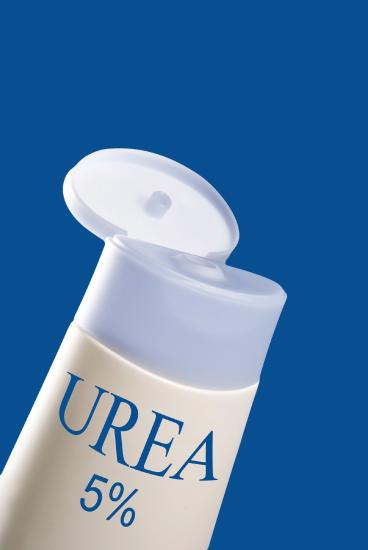15.03: Solution Concentration - Molality, Mass Percent, ppm and ppb
- Page ID
- 178209
A similar unit of concentration is molality (m), which is defined as the number of moles of solute per kilogram of solvent, not per liter of solution:
\[molality\: =\: \frac{moles\: solute}{kilograms\: solvent}\]
Mathematical manipulation of molality is the same as with molarity.
Another way to specify an amount is percentage composition by mass (or mass percentage, % m/m). It is defined as follows:
\[\%m/m\: =\: \frac{mass\: of\: solute}{mass\: of\: entire\: sample}\times 100\%\]
It is not uncommon to see this unit used on commercial products (Fig. 11.3.1 - Concentration in Commercial Applications)
Fig. 11.3.1 Concentration in Commercial Applications © Thinkstock
The percentage of urea in this package is 5% m/m, meaning that there are 5 g of urea per 100 g of product.
Example \(\PageIndex{1}\):
What is the mass percentage of Fe in a piece of metal with 87.9 g of Fe in a 113 g sample?
Solution
Using the definition of mass percentage, we have
\[\%m/m\: =\: \frac{87.9\, g\, Fe}{113\, g\, sample}\times 100\%=77.8\%\, Fe\]
Exercise \(\PageIndex{1}\)
What is the mass percentage of H2O2 in a solution with 1.67 g of H2O2 in a 55.5 g sample?
Answer
3.01%
Related concentration units are parts per thousand (ppth), parts per million (ppm) and parts per billion (ppb). Parts per thousand is defined as follows:
\[ppth\: =\: \frac{mass\: of\: solute}{mass\: of\: sample}\times 1000\]
There are similar definitions for parts per million and parts per billion:
\[ppm\: =\: \frac{mass\: of\: solute}{mass\: of\: sample}\times 1,000,000\]
and
\[ppb\: =\: \frac{mass\: of\: solute}{mass\: of\: sample}\times 1,000,000,000\]
Each unit is used for progressively lower and lower concentrations. The two masses must be expressed in the same unit of mass, so conversions may be necessary.
Example \(\PageIndex{1}\):
If there is 0.6 g of Pb present in 277 g of solution, what is the Pb concentration in parts per thousand?
Solution
Use the definition of parts per thousand to determine the concentration. Substituting
\[\frac{0.6g\, Pb}{277g\, solution}\times 1000=2.17\, ppth\]
Exercise \(\PageIndex{1}\)
If there is 0.551 mg of As in 348 g of solution, what is the As concentration in ppm?
Answer
1.58 ppm
As with molarity and molality, algebraic rearrangements may be necessary to answer certain questions.
Example \(\PageIndex{1}\):
The concentration of Cl– ion in a sample of H2O is 15.0 ppm. What mass of Cl– ion is present in 240.0 mL of H2O, which has a density of 1.00 g/mL?
Solution
First, use the density of H2O to determine the mass of the sample:
\[240.0\cancel{mL}\times \frac{1.00\: g}{\cancel{mL}}=240.0\, g\]
Now we can use the definition of ppm:
\[15.0\, ppm\: =\: \frac{mass\: of\: solute}{240.0\: g\: solution}\times 1,000,000\]
Rearranging to solve for the mass of solute,
\[mass\: solute =\: \frac{(15.0\, ppm)(240.0\: g\: solution)}{1,000,000}=0.0036g=3.6\, mg\]
Exercise \(\PageIndex{1}\)
The concentration of Fe3+ ion in a sample of H2O is 335.0 ppm. What mass of Fe3+ ion is present in 3,450 mL of H2O, which has a density of 1.00 g/mL?
Answer
1.16 g
For ionic solutions, we need to differentiate between the concentration of the salt versus the concentration of each individual ion. Because the ions in ionic compounds go their own way when a compound is dissolved in a solution, the resulting concentration of the ion may be different from the concentration of the complete salt. For example, if 1 M NaCl were prepared, the solution could also be described as a solution of 1 M Na+(aq) and 1 M Cl−(aq) because there is one Na+ ion and one Cl− ion per formula unit of the salt. However, if the solution were 1 M CaCl2, there are two Cl−(aq) ions for every formula unit dissolved, so the concentration of Cl−(aq) would be 2 M, not 1 M.
In addition, the total ion concentration is the sum of the individual ion concentrations. Thus for the 1 M NaCl, the total ion concentration is 2 M; for the 1 M CaCl2, the total ion concentration is 3 M.
Key Takeaway
- Quantitative units of concentration include molarity, molality, mass percentage, parts per thousand, parts per million, and parts per billion.
Exercise \(\PageIndex{1}\)
- Differentiate between molarity and molality.
-
Differentiate between mass percentage and parts per thousand.
-
What is the molarity of a solution made by dissolving 13.4 g of NaNO3 in 345 mL of solution?
-
What is the molarity of a solution made by dissolving 332 g of C6H12O6 in 4.66 L of solution?
-
How many moles of MgCl2 are present in 0.0331 L of a 2.55 M solution?
-
How many moles of NH4Br are present in 88.9 mL of a 0.228 M solution?
-
What volume of 0.556 M NaCl is needed to obtain 0.882 mol of NaCl?
-
What volume of 3.99 M H2SO4 is needed to obtain 4.61 mol of H2SO4?
-
What volume of 0.333 M Al(NO3)3 is needed to obtain 26.7 g of Al(NO3)3?
-
What volume of 1.772 M BaCl2 is needed to obtain 123 g of BaCl2?
-
What are the individual ion concentrations and the total ion concentration in 0.66 M Mg(NO3)2?
-
What are the individual ion concentrations and the total ion concentration in 1.04 M Al2(SO4)3?
-
If the C2H3O2– ion concentration in a solution is 0.554 M, what is the concentration of Ca(C2H3O2)2?
- If the Cl− ion concentration in a solution is 2.61 M, what is the concentration of FeCl3?
Answers
- Molarity is moles per liter, whereas molality is moles per kilogram of solvent.
-
-
0.457 M
-
-
0.0844 mol
-
-
1.59 L
-
-
0.376 L
-
-
Mg2+ = 0.66 M; NO3− = 1.32 M; total: 1.98 M
-
-
0.277 M


